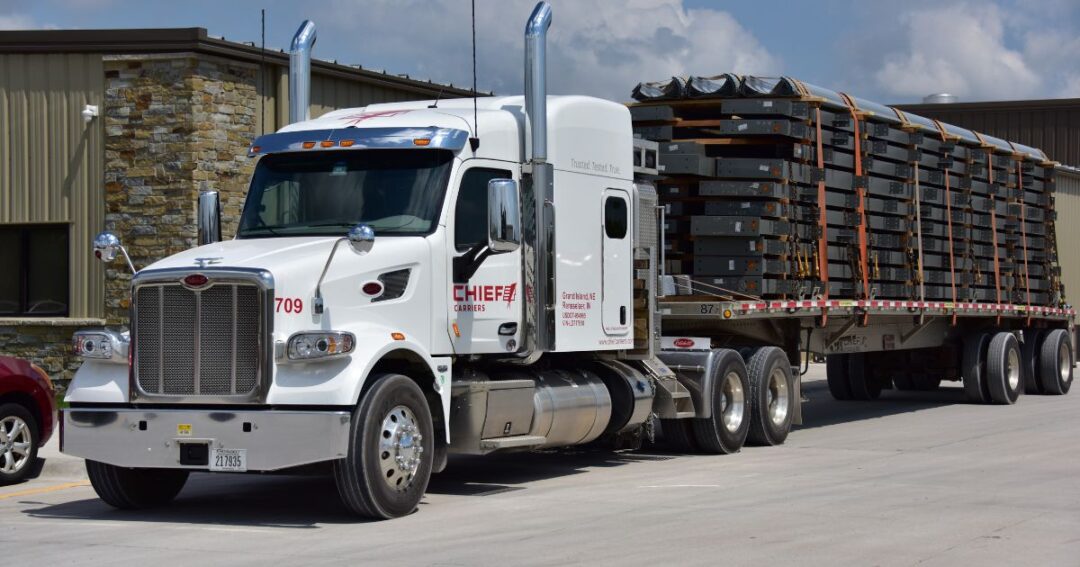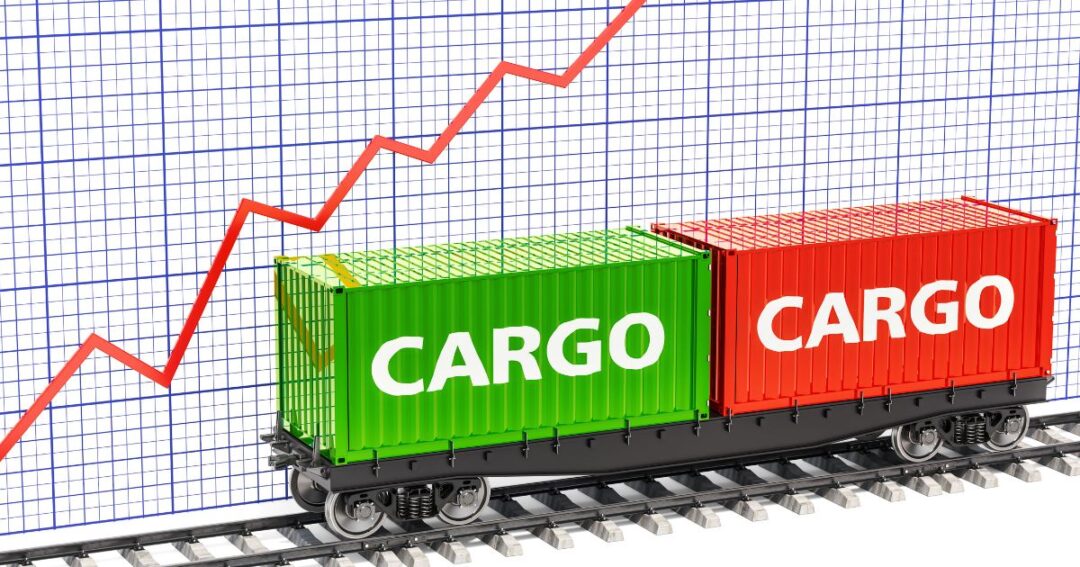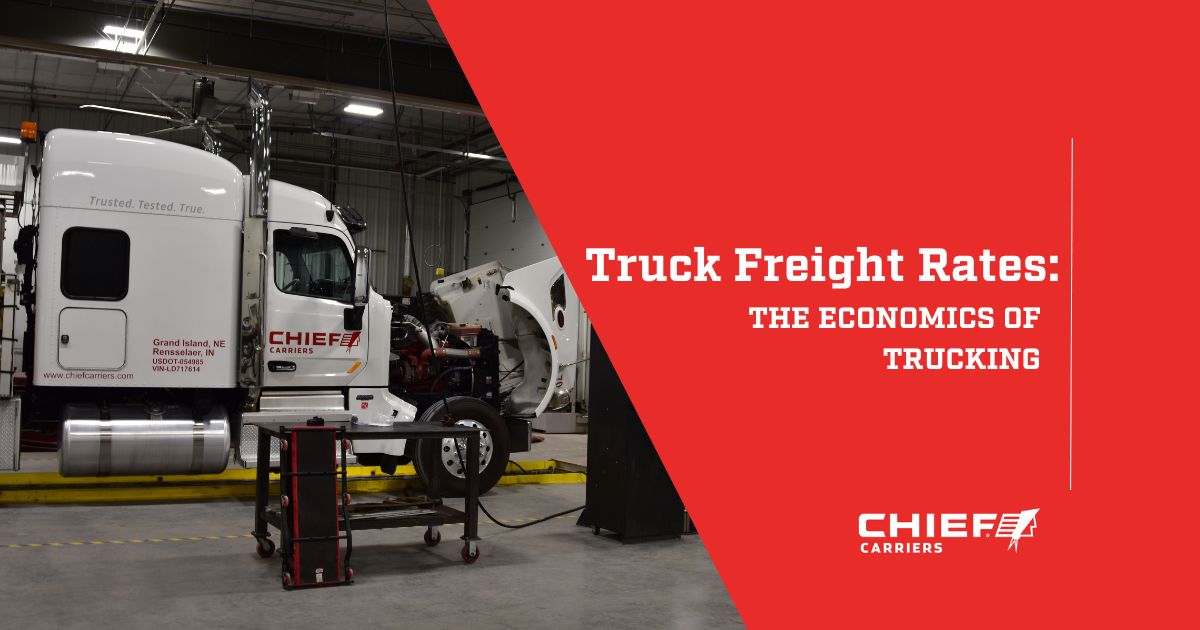Understanding Truck Freight Rates
Today, we’re veering into a topic that’s at the heart of our industry – the nuts and bolts of how freight rates are set.
It’s a subject that touches every one of us, whether you’re behind the wheel, dispatching loads, or even if you’re just curious about the economics of trucking.
In our latest Driven Too Far podcast episode, “How Freight Rates Are Determined,” we peeled back the layers of freight rate determination, a topic often shrouded in mystery and misconceptions.
But why does this matter to you?
Well, whether you’re negotiating your next load, planning your financial future, or simply trying to make sense of this vast industry, understanding freight rates is key.
Join me as we break down the complexities into something more digestible, shedding light on how these rates impact your daily grind and overall success in the trucking world.
Key Components of Freight Rates
Line Haul
The backbone of any freight rate is the ‘line haul’ component. This refers to the basic cost of moving freight from Point A to Point B. It’s the starting block of a rate, determined by the distance to be covered and the complexity of the haul.
For instance, hauling a load across multiple states inherently costs more than a short, intrastate trip. The line haul charge is influenced by factors like the route’s length, the type of goods being transported, and the required delivery speed.
A practical example can be seen in specialized cargo hauls. Transporting delicate or over-sized items often commands higher line haul rates due to the specialized equipment and expertise required.
Similarly, high-value goods might necessitate enhanced security measures, again raising the line haul cost.
For truckers, understanding line haul rates helps in selecting loads that are not just profitable but also align with their expertise and equipment capabilities.
Accessorial Fees
Accessorial fees cover the ‘extras’ not included in the line haul. These are additional charges for services that go beyond the standard pick-up and delivery.
Examples include loading and unloading fees, layover charges, detention (when a driver is held up at a pick-up or delivery point beyond a predetermined time), and tarp fees for flatbed trailers.
A real-life scenario illustrating accessorial fees could be a load requiring multiple stops for delivery. Each stop might incur a separate fee, reflecting the extra time and effort involved.
Similarly, if a trucker needs to wait several hours at a loading dock due to the shipper’s delay, detention fees would apply. These fees are vital for compensating drivers for their time and effort that go beyond driving, ensuring they are fairly paid for the full scope of their services.

Fuel Surcharge
Fuel surcharges are critical in offsetting the variable and often unpredictable cost of fuel. They fluctuate based on fuel price changes, ensuring that carriers and independent truckers aren’t financially strained by sudden spikes in fuel costs.
Typically, this surcharge is calculated as a percentage of the line haul rate or as an additional per-mile charge.
The impact of fuel surcharges on the overall freight rate is significant. For example, during periods of rising fuel prices, the surcharge will increase, helping to maintain the profitability of a haul.
Conversely, when fuel prices drop, the surcharge decreases, making freight costs more attractive to shippers without unduly impacting the carrier’s bottom line.
For truckers, especially those operating independently, understanding and effectively managing fuel surcharges is crucial for maintaining financial stability in the ever-fluctuating world of fuel economics.

Economic Dynamics and Geographic Considerations
In the trucking industry, economic dynamics and geographic considerations play pivotal roles in determining freight rates, making them as varied as the landscapes we drive through.
Influence of Supply and Demand on Freight Rates
The classic economic principle of supply and demand is a fundamental driver of freight rates. In regions with an oversupply of trucks and a scarcity of freight, rates tend to be lower.
Conversely, in areas where freight is abundant but trucks are few, rates naturally climb. This fluctuation is a constant dance, with rates responding almost in real-time to the supply-demand balance in each market.
For instance, consider a bustling port city with an influx of imported goods but a limited number of trucks to distribute them inland. The scarcity of transportation options can drive rates up, as shippers compete to secure trucking services.
On the other hand, in a manufacturing hub with many trucking companies vying for business, rates can be pushed down due to the surplus of transport options.
Impact of Location and Seasonality
Location and seasonality also significantly influence freight rates. Urban centers with congested traffic and challenging delivery locations, like New York City or Los Angeles, often command higher rates due to the additional time and skill required to navigate these areas.
Rural or less accessible regions might have lower rates, but they also come with their own set of challenges, like fewer load opportunities for the return trip.
Seasonality adds another layer of complexity. During peak seasons like the holiday rush in December or harvest seasons in agricultural areas, demand for trucking services spikes, pushing rates higher.
For example, during fall, when retail stores stock up for the holiday season, or in spring, when agricultural areas require refrigerated trucks for produce, rates in these sectors and regions can surge.

Real-World Examples
A trucker hauling refrigerated goods might find higher rates during the summer in the southern states, where the demand for moving perishable goods is higher due to the heat.
Similarly, rates might be higher for flatbed trucks transporting construction materials in areas experiencing a building boom.
These examples underscore the importance of understanding the economic and geographic factors that influence freight rates, enabling truckers to strategically plan their routes and services for maximum profitability.
Contract Rates vs Spot Rates
In the trucking industry, understanding the distinction between contract rates and spot rates is crucial for navigating the market effectively.
These two types of rates represent different approaches to securing loads and can significantly impact a trucker’s earnings and business stability.
Definitions and Differences
Contract Rates refer to pre-negotiated, fixed payment agreements between carriers and shippers. These rates are typically set for an extended period, often a year or more, providing a stable and predictable income stream.
Contract rates are based on a mutual understanding of consistent load volumes over time, allowing for better planning and resource allocation. They represent a long-term partnership where both parties can rely on a steady flow of business.
Spot Rates, on the other hand, are one-off, market-driven prices for individual loads. These rates are highly variable, fluctuating based on immediate supply and demand conditions.
Spot rates can offer higher potential earnings during times of high demand but lack the stability of contract rates. They are more common among independent owner-operators or smaller fleets that may not have consistent contractual relationships with shippers.

Practical Advice for Truckers
Navigating these rates requires a strategic approach. For those seeking stability and predictability in their business, pursuing contract rates with shippers is advisable.
Building relationships with a few reliable shippers can lead to long-term contracts, ensuring a steady income and reducing the uncertainties associated with fluctuating market conditions.
For those willing to take on more risk for potentially higher rewards, the spot market can be lucrative, especially during peak seasons or in high-demand regions.
However, it’s essential to stay informed about market trends and fuel costs, as these can significantly impact profitability. Tools like freight rate indexes can provide valuable insights into current market rates, helping truckers make informed decisions.
Balancing contract and spot market work can also be an effective strategy. While contract loads provide a base income, supplementing with spot market loads when rates are favorable can boost earnings.
This hybrid approach allows truckers to enjoy the stability of contracts while capitalizing on lucrative spot market opportunities.
The Role of Brokers and Third Parties
Brokers and third-party logistics providers (3PLs) are key players in the trucking industry, acting as intermediaries between shippers and carriers. They play a significant role in shaping freight rates and can greatly influence a trucker’s access to loads and overall earnings.
How Brokers Influence Freight Rates
Brokers typically have extensive networks and relationships with a variety of shippers, giving them access to a wide range of loads. They use their market knowledge and bargaining power to negotiate rates with shippers, then offer these loads to carriers, including independent truckers and smaller fleets.
Since brokers often focus on the spot market, they are instrumental in setting spot rates based on current supply and demand dynamics.
While brokers aim to secure the best possible rates from shippers, they also need to make their margins. This can lead to situations where the rates offered to truckers are lower than what might be obtained directly from shippers.
However, brokers provide value by saving truckers time and effort in finding loads, allowing them to focus more on driving and less on sales and marketing.

Tips for Truckers Dealing with Brokers
1. Build Relationships: Establishing a good rapport with brokers can lead to more and better load opportunities. Regular communication and reliable service can position you as a preferred carrier for certain brokers.
2. Negotiate Smartly: Don’t hesitate to negotiate with brokers. If you have a good understanding of the market rates and your operating costs, you can better argue for fair compensation.
3. Understand the Market: Stay informed about current market trends and rates. Tools like DAT and Truckstop.com provide valuable insights into prevailing spot rates, helping you evaluate the fairness of a broker’s offer.
4. Read the Fine Print: Before accepting a load, carefully review the broker’s terms. Look for any hidden fees or clauses that might affect your earnings.
5. Diversify Your Options: While brokers can be a valuable source of loads, relying solely on them can be risky. Diversify your sources by seeking direct shipper contracts, exploring different freight boards, and networking within the industry.
6. Prompt and Professional Service: Providing excellent service can lead to repeat business. Being on time, maintaining good communication, and handling cargo with care can make you a preferred choice for brokers.
By understanding and effectively navigating their relationships with brokers, truckers can access a broader range of loads, optimizing their routes and maximizing their earnings in the ever-changing landscape of the trucking industry.
Impact on Drivers and Earnings
The dynamics of freight rates in the trucking industry have a direct and significant impact on drivers’ earnings. This impact varies distinctly between company drivers and owner-operators or lease operators, with each group facing unique challenges and opportunities.
Impact on Company Drivers
Company drivers typically earn a fixed rate per mile or an hourly wage, providing them with a consistent income. Their earnings are less directly affected by fluctuations in freight rates since they are paid by their employer, the trucking company.
The stability can be comforting; however, it also means they don’t directly benefit from high rates in the spot market. In times of high demand, while the company might profit more, the company driver’s earnings generally remain constant unless the company decides to share these gains.

Impact on Owner-Operators/Lease Operators
Owner-operators and lease operators, who essentially run their own businesses, are more directly impacted by freight rate changes. They have the potential to earn more during periods of high demand and high spot rates but also face greater risks during market downturns.
Their earnings are directly tied to the rates they negotiate for each load, making an in-depth understanding of market trends and rate negotiation crucial.
Strategies for Drivers to Negotiate Better Rates
1. Stay Informed: Keeping abreast of market trends and rates in different regions and for different types of freight can empower drivers to negotiate better.
2. Build Strong Relationships: Developing relationships with regular clients or brokers can lead to better rates and more consistent loads.
3. Understand Your Costs: Knowing your operational costs, including fuel, maintenance, and insurance, is critical to negotiate rates that ensure profitability.
4. Negotiation Skills: Be confident in negotiating rates. Presenting your case clearly, highlighting your reliability and service quality, can influence better rates.
5. Leverage Technology: Use freight boards and mobile apps to find loads and compare rates. Technology can provide real-time insights into market rates, helping you make informed decisions.
6. Specialize in Niche Markets: Specializing in a particular type of freight, like hazardous materials or refrigerated goods, can command higher rates due to the specialized skills and equipment required.
7. Flexibility and Adaptability: Being flexible with routes and schedules can open opportunities for more lucrative loads.
For truckers, especially owner-operators and lease operators, understanding and strategically responding to the impact of freight rates on earnings is key to maintaining and enhancing their profitability in the dynamic trucking industry.

Truck Freight RatesToday
As we wrap up this deep dive into the intricate world of freight rates in the trucking industry, let’s revisit the key insights that can guide truckers and industry stakeholders in navigating these waters.
Firstly, understanding the key components of freight rates – line haul, accessorial fees, and fuel surcharge – is essential. Each component plays a critical role in the overall rate structure and significantly impacts earnings.
The line haul forms the core of the rate, while accessorial fees compensate for additional efforts beyond driving, and the fuel surcharge addresses the variable cost of fuel, protecting against market fluctuations.
The economic dynamics and geographic considerations are also pivotal. Factors like supply and demand, location specifics, and seasonality can cause significant variations in rates. Awareness of these factors enables truckers to strategically select routes and loads.
The contrast between contract rates and spot rates highlights the balance between stability and the potential for higher earnings. While contract rates provide predictable income, spot rates offer the flexibility to capitalize on market highs.
The role of brokers and third parties can’t be overlooked. They influence the market, and understanding how to effectively work with them can open up more lucrative opportunities.
The impact on drivers and earnings varies between company drivers and owner-operators/lease operators. Company drivers enjoy stability, whereas owner-operators are directly affected by rate fluctuations, requiring astute negotiation skills and market knowledge.
For a more in-depth exploration of these topics and to hear more stories from the road, I invite you to listen to the full episode of “Driven Too Far: The Truth About Trucking.” You can find it on our website, as well as on Spotify, Apple Podcasts, and YouTube. Each episode is designed to give you the insights and advice you need to navigate the trucking industry’s challenges.
Andrew Winkler
Andrew Winkler is the only executive in the trucking industry willing to get in the cab and listen to you. He started out in the driver’s seat like you–loving a life on the road, missing a family at home, and yelling at dispatch over the phone. He knows how it feels to be driven too far, which is why he’s giving you the truth about trucking so you can have both your family and your career.
Interested in having Andrew Winkler appear as a guest on your show? Have a show topic idea? Want to appear as a guest on Driven Too Far? Have a question?

